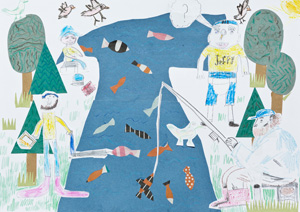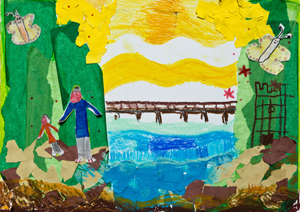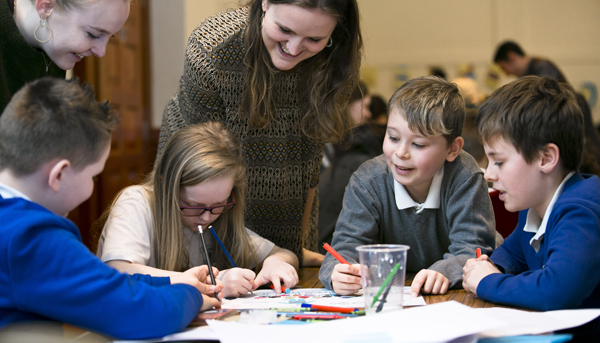This resource is great for:
Empowering your class to write and illustrate their own books.
Summary:
A step-by-step guide for creating a picture book inspired by the place where you live.
Introduction:
The Book Festival recently worked with four P5/P6 classes in Cumbernauld, helping them to write and illustrate their own stories about their hometown.
Click the picture below to read ‘A Bridge from Everywhere’ – created by the P6 class at Kildrum Primary School:

You can read the rest of the wonderful stories, and find out more about the project, over on our Booked! blog.
The Cumbernauld classes had the help of author Mike Nicholson but the structure of the project is easily replicable for any class.
Activity – Creating Your Own Picture Book
Part One – Write Your Story!
Why not use one of our writing prompts – such as a ‘Mind’s Eye’ Walk or My Town: The Movie – to get you thinking and writing about the place where you live? Use history, location, a character or a story about your town as a starting point – but be imaginative and let your story take off from there (our Cumbernauld classes certainly did!) You can write your story individually or as a whole class by brainstorming the plot together and then splitting into groups to write each section.
Top tips:
- Let your imagination go wild as you write, and then when you’re finished go back over it and edit to make sure it makes sense.
- Remember to break up the action into chapters.
- Cliffhangers and a twist in your plot can really help to make your story exciting.
Part Two – Design Your Book
Once you’ve finished writing the story, it’s time to make it look like a proper book!
Top tips:
- Before you start, decide how much text you want on each page.
- Add page numbers and decide how you want to align your text (left, centre?) – make sure it’s easy to read.
- It’s a good idea to have one piece of action or location per page (so it’s easier to draw later on!)
- Our Cumbernauld classes had 12 pages per story – but decide how many suits your story.

Part Three – Get Drawing!
Our Cumbernauld classes had some wonderful illustration students from the Edinburgh College of Art to help them with their illustrations (thanks guys!). But you don’t need help to create some fantastically arty accompaniments to your story.
Top tops:
- Before you start, think about what each of your characters looks like for continuity (especially if you’ve written the story as a class).
- Read each page and identify where the action is set, and what’s happening. Then think about what you would draw to represent that scene.
- It might be helpful to draw in pencil first (remember to fill the whole page!) before you add pen, colour in, or stick in other paper etc for a collage.
- You can either use your original drawing in the book, or take a photo and use it (which might be a good idea if you’ve done lots of collaging!)
Part Four – In a Bind
There are lots of tutorials online for bookbinding – so if you’d rather do something more advanced, just have a quick google. We’re going to talk you through a really simple way of doing it:
- Make four holes along the left hand side of your paper using a hole punch or knitting needle (and a piece of blue tack on the back). For younger children, we recommend that an adult helps!
- Then, simply thread a ribbon or some wool through each hole, tying it at the spine.
You could also get your book professionally printed and bound. Why not get multiple copies made and sell them to parents as a fundraiser?
And there you have it! Your own beautifully handmade-from-scratch book! Now you know the basics, you can go on to make a book about anything. Tiny little books could be made about pets, or why not create a holiday diary and fill it up over the holidays. The book world is your oyster!
Further information:
Read all of the brilliant stories from our Cumbernauld residency primary schools on the Booked! blog.
Booked! is Edinburgh International Book Festival on the road around Scotland throughout the year, supported by players of People’s Postcode Lottery.
